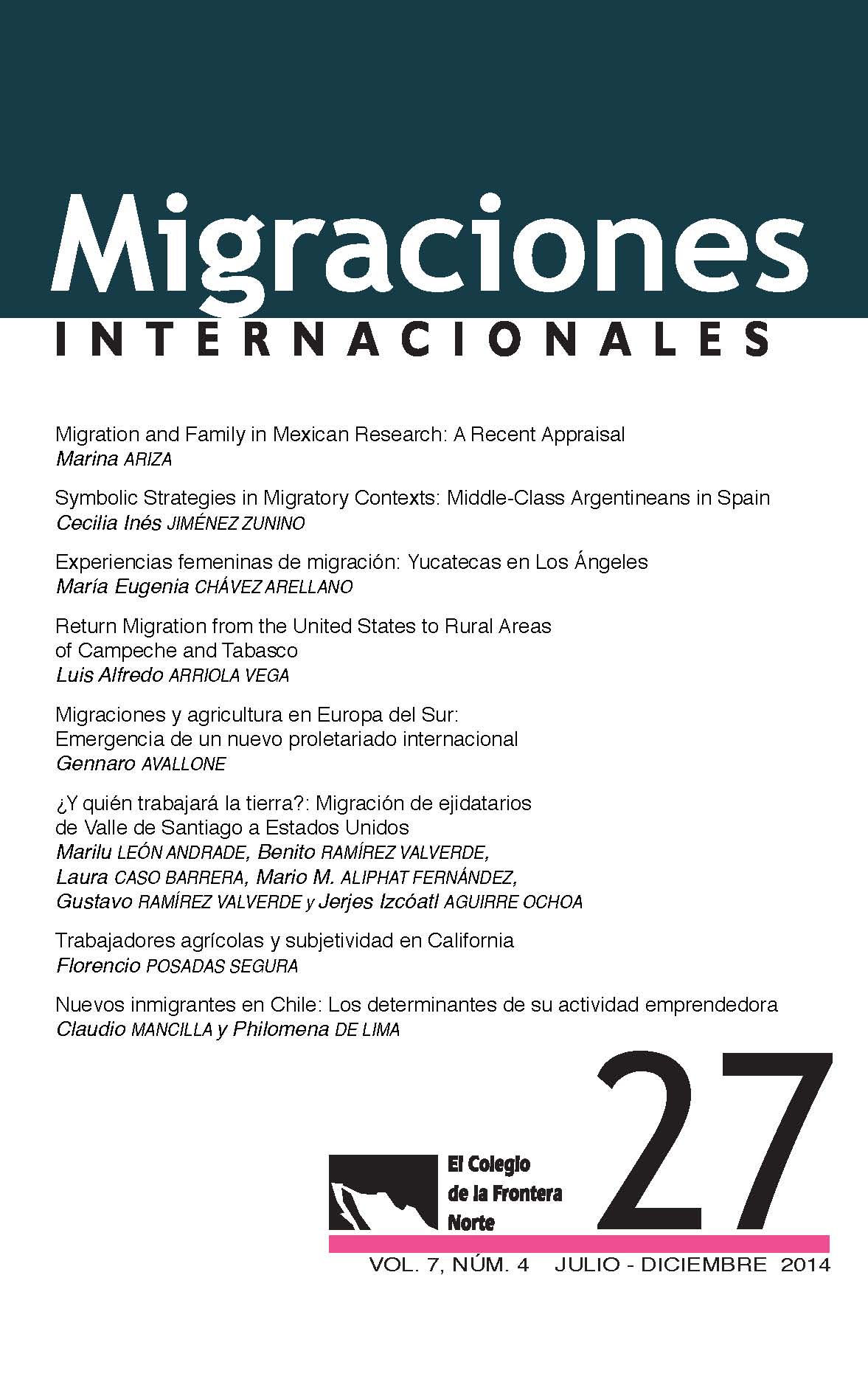Nuevos inmigrantes en Chile: Los determinantes de su actividad emprendedora
DOI:
https://doi.org/10.17428/rmi.v7i27.662Palabras clave:
inmigrantes, emprendedor, extranjeros, Chile, SudamericaResumen
En Chile es poca la literatura que estudia a los inmigrantes desde una perspectiva económica, y menos la que aborda su actitud emprendedora (a pesar de que son proporcionalmente más emprendedores que los habitantes locales).
El objetivo de este trabajo es estudiar los factores que influyen en el emprendimiento de los inmigrantes sudamericanos en Chile. Se utilizó un modelo logit ajustado para eventos extraños para determinar el impacto sobre la probabilidad de emprendimiento individual. Algunos resultados indican que el tiempo de residencia, forma legal de ingreso al país, nivel educacional y experiencia previa de emprendimiento, influyen en la probabilidad de crear una actividad empresarial.
New Immigrants in Chile: Determinants of their Entrepreneurship
Abstract
There is a dearth of economic literature that has focused on immigrants in Chile and their entrepreneurship. This is despite evidence that suggests immigrants are proportionally more likely to engage in entrepreneurial activities than local inhabitants.
The objective of this paper is to explore the factors that influence individual’s to engage in entrepreneurial activities among immigrants from South America in Chile. A rare event logit model was used to assess the factors that are likely to impact on entrepreneurial decision making processes. Results indicate that: length of residence, legal status on entry into the country, educational level and previous entrepreneurial experience influence the likelihood of entrepreneurship.
Referencias
GARWAL, Sheela; Sanzidur RAHMAN y Andrew ERRINGTON, 2009, “Measuring the Determinants of Relative Economic Performance of Rural Areas”, Journal of Rural Studies,
vol. 25, pp. 309-321.
AMORÓS, José Ernesto y Massiel GUERRA, 2009, Global Entrepreneurhsip Monitor. Reporte Nacional de Chile 2008, Santiago, Universidad Adolfo Ibáñez/Universidad del Desarrollo/
Global Entrepreneurship Research Association, en <http://negocios.udd.cl/files/2010/10/gem-nacional.pdf>, consultado el 18 de abril de 2011.
BALTAR, Fabiola e Ignasi BRUNET, 2013, “Estructura de oportunidades y comportamiento emprendedor: Empresarios argentinos en Cataluña, España”, Migraciones Internacionales 25,
vol. 7, núm, 2, julio-diciembre, pp. 9-38.
BARAÑAO DÍAZ, Joaquín [ponencia], 2012, “Los criterios y lineamientos básicos de la nueva ley de migraciones del gobierno”, en seminario “Migración peruana en la ciudad de Santiago: Nueva legislación e integración socio cultural”, Fundación Chile 21/Universidad Central de Chile, 9 de noviembre, en <http://www.chile21.cl/wp-content/uploads/2012/11/PL_Migraciones_-_SEMINARIO_Chile_XXI-1.pdf>, consultado el 10 de noviembre de 2012.
BATES, Timothy, 1997, “Financing Small Business Creation:
The Case of Chinese and Korean Immigrant Entrepreneurs”,
Journal of Business Venturing, vol. 12, núm. 2, pp. 109-124.
BEGLEY, Thomas y Wee-Liang TAN, 2001, “The Socio-cultural Environment for Entrepreneurship: A Comparison between
East Asian and Anglo-saxon Countries”, Journal of International Business Studies, vol. 32, núm. 3, pp. 537-553.
BORJAS, George, 1986, “The Self-employment Experience of
Immigrants”, The Journal of Human Resources, vol. 21, núm. 4,
pp. 485-506.
BORJAS, George, 1987, “Immigrants, Minorities and Labour
Market Competition”, Industrial & Labor Relations Review,
vol. 40, núm. 3, pp. 382-392.
BOSMA, Niels; Zoltan J. ACS, Erkko AUTIO, Alicia CODURAS
y Jonathan LEVIE [publicación digital], 2009, “Global Entrepreneurship Monitor (gem): 2008 Executive Report”, Babson College/Universidad del Desarrollo/London Business School/Global Entrepreneurship Research Consortium, en <http://www.gemconsortium.org/docs/download/264>, consultado el 10 de noviembre de 2012.
BRUDER, Jana y Solvig RÄTHKE-DÖPPNER, 2008, “Ethnic Minority Self-employment in Germany: Geographical Distribution and Determinants of Regional Variation”, Thuenen-Series of Applied Economic Theory, Rostock, Alemania, Department of Economics-University of Rostock, núm. 100, en <http://econpapers.repec.org/RePEc:ros:wpaper:100>, consultado el 27 de enero de 2009.
CARD, David, 2001, “Immigrant Inflows, Native Outflows, and
the Labor Market Impacts of Immigration”, Journal of Labor
Economics, vol. 19, pp. 22-64.
CARRASCO, Lorena, 2010, “Transnational Family Life among
Peruvian Migrants in Chile: Multiple Commitments and the
Role of Social Remittances”, Journal of Comparative Family
Studies, vol. 41, núm. 2, pp. 187-204.
CARTER Sara; Susan ANDERSON y Eleanor SHAW, 2001,
“Women’s Business Ownership: A Review of the Academic,
Popular and Internet Literature”, Glasgow, Escocia, Small Business Service, en <http://www.berr.gov.uk/files/file38362.pdf>, consultado el 20 de enero de 2009.
CAUSSA, Aleix, 2007, Immigració I emprenedoria: De l’exclusió
financera a la creció d’activitats generadores de riqueza, Barcelona, Fundació Un Sol Món de Caixa Catalunya.
CLARK, Kenneth y Stephen DRINKWATER, 2000, “Pushed
Out or Pulled In? Self-Employment among Ethnic Minorities
in England and Wales”, Labour Economics, vol. 7, pp. 603-628.
CODURAS, Alicia, 2008, “La actividad emprendedora de los inmigrantes en España, 2005-2007”, ICE. Revista de Economía,
vol. 841, pp. 97-116.
CONSTANT, Amelie y Klaus ZIMMERMANN, 2006, “The
Making of Entrepreneurs in Germany: Are Native Men and
Immigrant Alike?”, Small Business Economics, vol. 26, núm. 3,
pp. 279-300.
DE LIMA, Philomena; Birgit JENSTCH y Robert WHELTON, 2005, Migrant Workers in the Highlands and Islands, Inverness,
Escocia, Highlands and Islands Enterprise.
DE LIMA, Philomena; Maariyah MASUD, Robert WHELTHON y Rowena ARSHAD, 2007, “A Study of Migrant Workers in Grampian”, Research from Communities Scotland,
Edimburgo, Communities Scotland, julio (Report 89), en
<http://www.scotland.gov.uk/Resource/Doc/1125/0086222.pdf>, consultado el 10 de enero de 2009.
DELMAR, Frédéric y Carin HOLMQUIST, 2004, “Women’s
Entrepreneurship: Issues and Policies”, en “2nd Organization
for Economic Co-operation and Development (oecd), Conference of Ministers Responsible for SMEs, Promoting Entrepreneurship and Innovative SMEs in a Global Economy”, Estambul, 3-5 de junio.
DE NEW, Jhon P. y Klaus F. ZIMMERMANN, 1994, “Native Wage Impacts of Foreign Labor: A Random Effects Panel Analysis”, Journal of Population Economics, vol. 21, pp. 229-234.
DONKELS, Rik, 1991, “Education and Entrepreneurship Experiences from Secondary and University Education in Belgium”, Journal of Small Business and Entrepreneurship, vol. 9, pp. 7-21.
GARTNER, William, 1985, “A Framework for Describing and
Classifying the Phenomenon of New Venture Creation”, Academy of Management Review, vol. 10, núm. 4, pp. 696-706.
GELDRES, Valeska; Ana María RUSQUE y María Soledad
ETCHEBARNE, 2011, “La visión de un inmigrante checo en
la Araucanía a mediados del siglo xx: El hotel Antumalal de
Pucón”, en Jorge Pinto Rodríguez, edit., Araucanía, siglos xix y
xx. Economía, migraciones y marginalidad, Osorno, Chile, Universidad de Los Lagos, pp. 85-108.
GREENE, William, 2006, Análisis econométrico. Tercera edición,
Madrid, Prentice Hall.
GROSSMAN, Jean, 1982, “The Sustainibility of Natives and
Immigrants in Production”, Review of Economics and Statistics,
vol. 64, núm. 4, pp. 596-603.
HAISKEN-DENEW, Jhon P. y Klaus ZIMMERMANN, 1995,
“Wage and Mobility Effects of Trade and Migration”, Discussion Paper, Londres, Centre for Economic Policy Research,
núm. 1318.
HANSSON, Åsa, 2010, “Tax Policy and Entrepreneurship: Empirical Evidence from Sweden”, Small Business Economics, vol.
, núm. 4, enero, pp. 495-513.
HAYTER, Roger, 1997, The Dynamics of Industrial Location: The
Factory, the Firm and the Production System, Nueva York, John
Wiley & Son Ltd.
KALANTARIDIS, Christos y Zografia BIKA, 2006, “In-migrant Entrepreneurship in Rural England: Beyond Local Embeddedness”, Entrepreneurship & Regional Development, vol. 18, pp. 109-131.
KATZ, Jerome, 1994, “Modelling Entrepreneurial Career Progressions: Concepts and Considerations”, Entrepreneurship Theory and Practice, vol. 19, pp. 23-36.
KING, Gary y Langche ZENG, 2001a, “Logistic Regression in
Rare Events Data”, Political Analysis, vol. 9, núm. 2, pp. 137-163.
KING, Gary y Langche ZENG, 2001b, “Explaining Rare Events
in International Relations”, International Organization, vol. 55,
núm. 3, pp. 693-715.
KRUEGER, Norris, 1993, “The Impact of Prior Entrepreneurial
Exposure on Perceptions of New Venture Feasibility and Desirability”, Entrepreneurship Theory and Practice, vol. 18, pp. 5-21.
KRUEGER, Norris y Deborah BRAZEAL, 1994, “Entrepreneu-
rial Potential and Potential Entrepreneurs”, Entrepreneurship
Theory and Practice, vol. 8, pp. 91-104.
LALONDE, Robert y Robert TOPEL, 1992, “The Assimilation
of Immigrants in the U. S. Labor Market”, en George Borjas y Richard Freeman, edits., Immigration and the Workforce:
Economic Consequences for the United States and Source Areas,
Chicago, University of Chicago Press, pp. 67-92, en
www.nber.org/chapters/c6906.pdf>, consultado el 20 de enero
de 2010.
LEVIE, Jonathan, 2007, “Immigration, In-migration, Ethnicity
and Entrepreneurship in the United Kingdom”, Small Business
Economics, vol. 28, pp. 143-169.
LEVIN, Richard I. y David S. RUBIN, 2010, Estadística para
administración y economía. Séptima Edición., Naucalpan de
Juárez, México, Pearson Educación.
LIGHT, Ivan; Parminder BHACHU y Stavros KARAGEORGIS,
, “Migration Networks and Immigrant Entrepreneurship”, en Ivan Light y Parminder Bhachu, edits., Immigration
and Entrepreneurship: Culture, Capital, and Ethnic Networks,
New Brunswick/Londres, Transaction Publishers, pp. 25-50.
LUQUE, José, 2007, “Asociaciones políticas de inmigrantes peruanos y la Lima Chica en Santiago de Chile”, Migraciones Internacionales 13, vol. 4, núm. 2, julio-diciembre, pp. 121-150.
MALACH-PINES, Ayala; Haim LEVY, Agnes UTASI y T. L.
HILL, 2005, “Entrepreneurs as Cultural Heroes: A Cross-
cultural, Interdisciplinary Perspective”, Journal of Managerial
Psychology, vol. 20, núm. 6, pp. 541-555.
MANCILLA, Claudio y José Ernesto AMORÓS, 2012, “La influencia de factores socio-culturales en el emprendimiento, evidencia en Chile 2007-2010”, Multidisciplinary Business Review, vol. 5, núm. 1, pp. 15-25.
MANCILLA, Claudio; Lourdes VILADOMIU y Carlos GUALLARTE, 2010, “Emprendimiento, inmigrantes y municipios rurales”, Revista de Economía Agraria y Recursos Naturales, vol.
, núm. 2, pp. 123-144.
MARTÍNEZ, Jorge, 2001, “Reflexiones sobre la gobernabilidad
de la migración internacional en América Latina”, Migraciones
Internacionales 1, Tijuana, El Colegio de la Frontera Norte, vol.
, núm. 1, julio-diciembre, pp. 88-110.
MESTRES, Josep, 2007, “Perspectivas laborales de la reciente inmigración en España”, en Guillem López, edit., Inmigración y
transformación social en Cataluña, Volumen I. Aspectos socioeconómicos del fenómeno inmigratorio: Las cuestiones relevantes, Bilbao, Fundación BBVA/Generalitat de Catalunya, pp. 163-182.
MILLER, Kerry, 2007, “The Impact of Immigrant Entrepreneurs”,
BusinessWeek, en sección “Small Business”, 6 de febrero, en <http://www.businessweek.com/stories/2007-02-06/the-impact-
of-immigrant-entrepreneursbusinessweek-business-news-stock-market-and-financial-advice>, consultado en enero de 2009.
MINISTERIO DEL INTERIOR DE CHILE, 2008, “Inmigración, equidad de género y seguridad pública”, Santiago, Gobierno de Chile/Ministerio del Interior.
MINISTERIO DEL INTERIOR DE CHILE, 2010, “Informe Anual. Departamento de Extranjería y Migración”, Santiago, Gobierno de Chile/Ministerio del Interior, en <http://www.extranjeria.gov.cl/filesapp/Informe%20Estimacion%20Poblacion%20Extranjeros%202008.pdf >, consultado el 10 de enero de 2012.
MORA, Claudia, 2008, “The Peruvian Community in Chile”,
Peace Review, vol. 20, núm. 3, pp. 339-347.
MUÑOZ, José, 2011, “El trabajador de pies calientes. Notas relativas a las causas de la migración laboral desde la frontera sur araucana a la Norpatagonia argentina. Fines del siglo xix”, en
Jorge Pinto, edit., Araucanía, siglos xix y xx. Economía, migraciones y marginalidad, Osorno, Chile, Universidad de Los Lagos, pp. 49-69.
NORTH, David y David SMALLBONE, 1996, “Small Business Development in Remote Rural Areas: The Example of Mature Manufacturing Firms in Northern England”, Journal of Rural Studies, vol. 12, núm. 2, pp. 151-167.
ORGANIZATION FOR ECONOMIC CO-OPERATION AND DEVELOPMENT (OECD), 2003, Entrepreneurship and
Local Economic Development: Programme and Policy Recommendations, París, oecd.
ORGANIZACIÓN PARA LA COOPERACIÓN Y EL DESAR-
ROLLO ECONÓMICOS (OCDE), 2010, Perspectivas económicas de América Latina 2010. Resumen, París, oecd, en:
www.oecd.org/dev/latinamericaandthecaribbean/44305080.
pdf>, consultado el 30 de marzo de 2012.
PETRIN, Tea, 1997, “Entrepreneurship as An Economic Force in
Rural Development”, en Tea Petrin y Agnes Gannon, comps.,
Rural Development through Entrepreneurship, Roma, FAO Regional Office Europe (REU Technical Series 41), en
www.fao.org/docrep/W6882E/W6882E00.htm>, consultado el
de abril de 2010.
PSALTOPOULUS, Demetris; Sophia STATHOPOULOU y
Dimitris SKURAS, 2005, “The Location of Markets, Perceived
Entrepreneurial Risk, and Start-up Capital of Micro Rural
Firms”, Small Business Economics, vol. 25, pp. 147-158.
REYNOLDS, Paul y Sammis WHITE, 1997, The Entrepreneur-
ial Process: Economic Growth, Men, Women, and Minorities,
Westport, Estados Unidos, Quorum Book.
REYNOLDS, Paul; Niels BOSMA, Erkko AUTIO, Steve
HUNT, Natalie DE BONO, Isabel SERVAIS, Paloma LÓPEZ y Nancy CHIN, 2005, “Global Entrepreneurship Monitor: Data Collection Design and Implementation 1998-2003”,
Small Business Economics, vol. 24, pp. 205-231.
SEGOVIA, Aloisia, 2011, “Spatial Research Study of Peruvian
Immigrants in Santiago de Chile”, Geografski Zbornik / Acta
Geographica Slovenica, vol. 51, núm. 1, pp. 190-203.
SHANE, Scott y Sankaran VENKATARAMAN, 2000, “The
Promise of Entrepreneurship as a Field of Research”, Academic
of Management Review, vol. 25, pp. 217-226.
Descargas
Publicado
Número
Sección
Licencia
Las/los autoras/es que publiquen en esta revista aceptan las siguientes condiciones:
- Las/los autoras/es conservan los derechos de autor y ceden a la revista Migraciones Internacionales (RMI) el derecho de la primera publicación, mediante el registro de los textos con la licencia de Creative Commons Atribución-No comercial-Sin derivar 4.0 internacional (CC BY-NC-ND 4.0), que permite a terceros utilizar lo publicado siempre que mencionen la autoría del trabajo y a la primera publicación en esta revista.
- Autorizan que su artículo y todos los materiales incluidos en él sean reproducidos, publicados, traducidos, comunicados y transmitidos públicamente en cualquier forma o medio; así como efectuar su distribución al público en el número de ejemplares que se requieran y su comunicación pública, en cada una de sus modalidades, incluida su puesta a disposición del público a través de medios electrónicos o de cualquier otra tecnología, para fines exclusivamente científicos, culturales, de difusión y sin fines comerciales.
- Los autores/as pueden realizar otros acuerdos contractuales independientes y adicionales para la distribución no exclusiva de la versión del artículo publicado en esta revista (por ejemplo: incluirlo en un repositorio institucional, página web personal; o bien publicarlo en un libro) siempre que sea sin fines comerciales e indiquen claramente que el trabajo se publicó por primera vez en Migraciones Internacionales (RMI), [agregando la ficha bibliográfica correspondiente: Autor/es. (año). Título del artículo. Migraciones Internacionales, volumen (número), pp. doi: xxxx ].
Para ello, las/los autoras/es deben remitir el formato de carta-cesión de la propiedad de los derechos de la primera publicación debidamente llenado y firmado. Este documento debe cargarse en formato PDF en archivos complementarios dentro de la plataforma OJS.
Este obra está bajo una licencia de Creative Commons Atribución-No comercial-Sin derivar 4.0 internacional (CC BY-NC-ND 4.0)..













